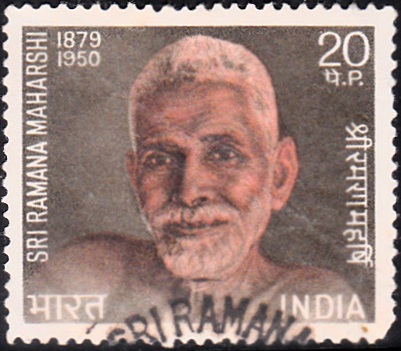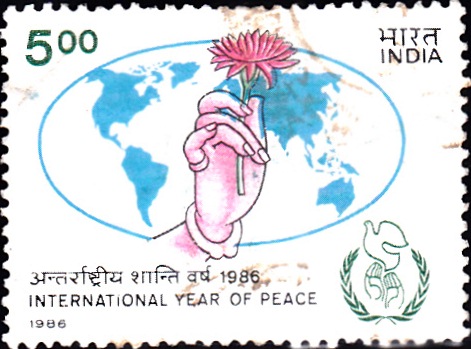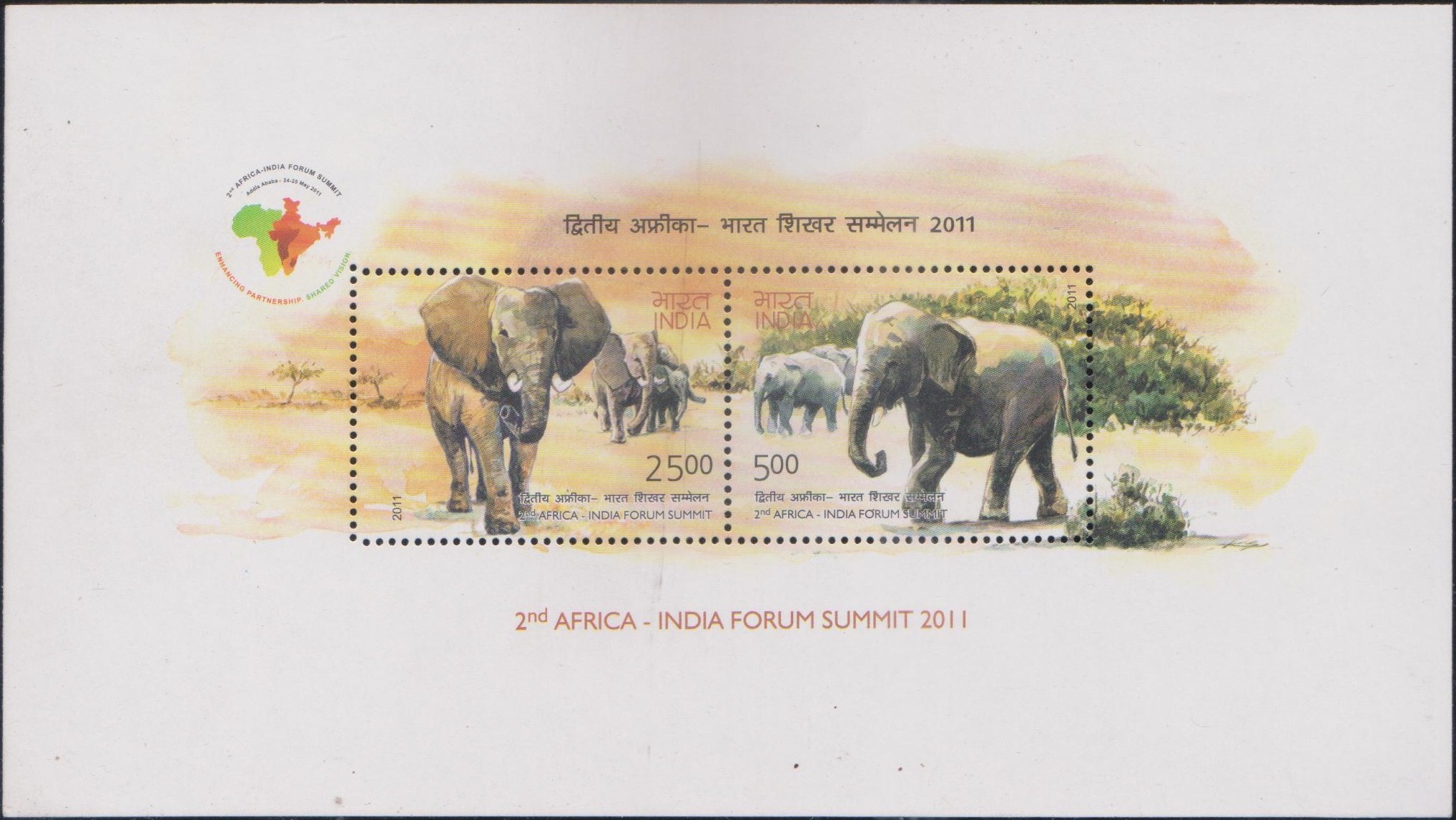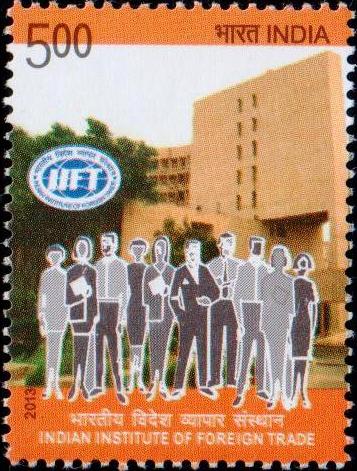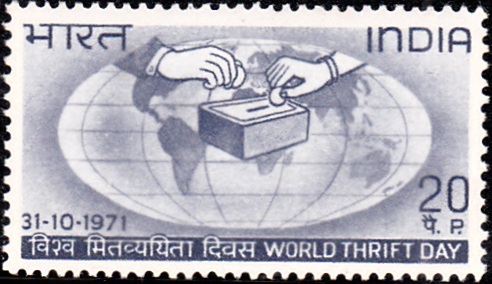
India on World Thrift Day 1971
A commemorative postage stamp on the World Savings Day : 31 October, a day devoted to promotion of savings in all over the World :
Issued on Oct 31, 1971
Issued for : The Posts and Telegraph Department plays an important role in promoting habits of thrift and feel privileged to be associated with the world wide celebrations of the World Thrift Day by bringing out this special commemorative stamp.
Description of Design : The design of the stamp is horizontal and depicts a picture of the Globe and a saving box in the middle with two hands each holding a coin.
Type : Stamp, Mint Condition
Colour : Blue Grey
Denomination : 20 Paise
Overall Size : 4.06 X 2.28 cms.
Printing Size : 3.80 X 2.00 cms.
Perforation : 14 x 14½
Watermark : Printed on unwatermarked adhesive stamp paper
Number Printed : 30,00,000
Number per issue sheet : 50
Printing Process : Photogravure
Designed and Printed at : India Security Press
About :
- 31st of October every year is observed in many countries as the World Thrift Day. On this day, savings institutions and workers revive their faith in the ideal of thrift as a step to human happiness.
- The origin of this innovation goes to the year 1924. In that year, the International Savings Bank Congress held in Milan, proclaimed the last day of their meet, 31st October, to be observed as World Thrift Day. The resolution, among other things, emphasised the practice and propaganda of saving, and that 31st October would be specially devoted to the promotion of thrift from an International standpoint.
- The significance of the World Thrift Day is that it provides a unique opportunity to strengthen the ties with the public. It is a day on which the savings banks stand in full light of publicity, when young and old hurry, to the savings banks in order to take part in the festivities. World Thrift Day provides an opportunity to impress on the entire savings bank staff the importance of the task of rendering service to the public.
- In India, the National Savings Organisation has been closely associated with the activities of the World Thrift Day. The annual National Savings Fortnight is inaugurated on that day.
- The foundations for the first savings institution in India were laid in the year 1833 when the Presidency Bank in Calcutta was established to provide for “the investment of the savings of all classes – British and native”. Later, the Presidency Banks at Madras and Bombay started accepting savings deposits in 1834 and 1835, respectively. In the 1860’s the question of extension of the scheme to the whole of India was considered, modelling on the Postal Savings Banks, which worked with “great success” in England. Thus, the Post Office Savings Bank came into being in 1881 with the primary object of providing facility of investment of the savings to the common man thereby encouraging the habit of thrift. However, there was no organised savings movement as such in existence in India to work for the mobilisation of savings of the people till the Second World War.
- In October, 1943, the Government of India set up the National Savings Central Bureau in Simla with a small staff primarily to promote thrift, to counteract the inflationary trends caused in the economy during the Second World War and to collect funds to finance the war efforts. With the encouraging results achieved by this Bureau with the co-operation of the Provincial Governments in the steady mobilisation of resources in the country, the Government of India reorganised the savings movement in May, 1948, in order to sustain and develop public interest in the movement. A full-fledged national savings organisation now functions in the country with the National Savings Commissioner as its head and a number of regional and other offices at the State, Divisional and District levels. Various types of savings bank accounts and savings certificates (some of them with attractive tax concessions) are offered to cater to the needs of different sections of the people. Very recently, new schemes have been introduced so as to make them more attractive for all classes of societies. In addition to campaigns undertaken periodically, the National Savings Organisation undertakes continuous and intensive publicity and propaganda through all media for the various small savings schemes. The State Governments who have also a vital interest in the progress of the movement (inasmuch as they are given a major share of the net collections as loans for their developmental programmes) also actively participate in the programmes for popularisation of small savings schemes. The National Savings Organisation has also the co-operation of a large number of authorised agents, voluntary workers, officials and non-officials, in this important task of mobilisation of internal resources of the country for the successful execution of various plan programmes. The progress made in deposit mobilisation has been very satisfactory. During 1870-71, the net collections amount to a little less than 200 crores of rupees. The total outstandings under the various small savings schemes now stand at a little over Rs. 2,200 crores and these form about 29 per cent of the country’s internal debt.
- The State Bank of India and the post offices serve the movement in selling these securities to the public and render service to the investors. It will be worthwhile recalling here the yeoman service rendered by the post offices in a silent and unostentatious way in this national endeavour. The number of post office savings banks in the country which was hardly 6,500 at the beginning of the century, has now exceeded a lakh. Nearly 90% of all the post offices in the country are authorised to transact savings bank business and it is hoped very shortly to vest the remaining 10 per cent of the post offices also with powers to do savings bank work. Most of these post office savings banks serve rural or semi-urban communities where, till recently, very few commercial banks ventured. Thus, in the context of the green revolution and the growing rural prosperity, the Post Office Savings Bank is playing a vital role, in mopping up the surplus money for nation-building activities. It holds a sum of Rs. 2,221 crores in the form of deposits in the savings bank and other accounts and outstandings in savings certificates. The number of depositors exceeds 2.4 crores.
- Savings is a virtue and a discipline for every citizen. Savings and investment in approved small savings schemes help not only the saver but also the country which has to find resources for the various nation-building schemes to achieve a sustained rate of growth of the national income and to fight the inflationary trends.





